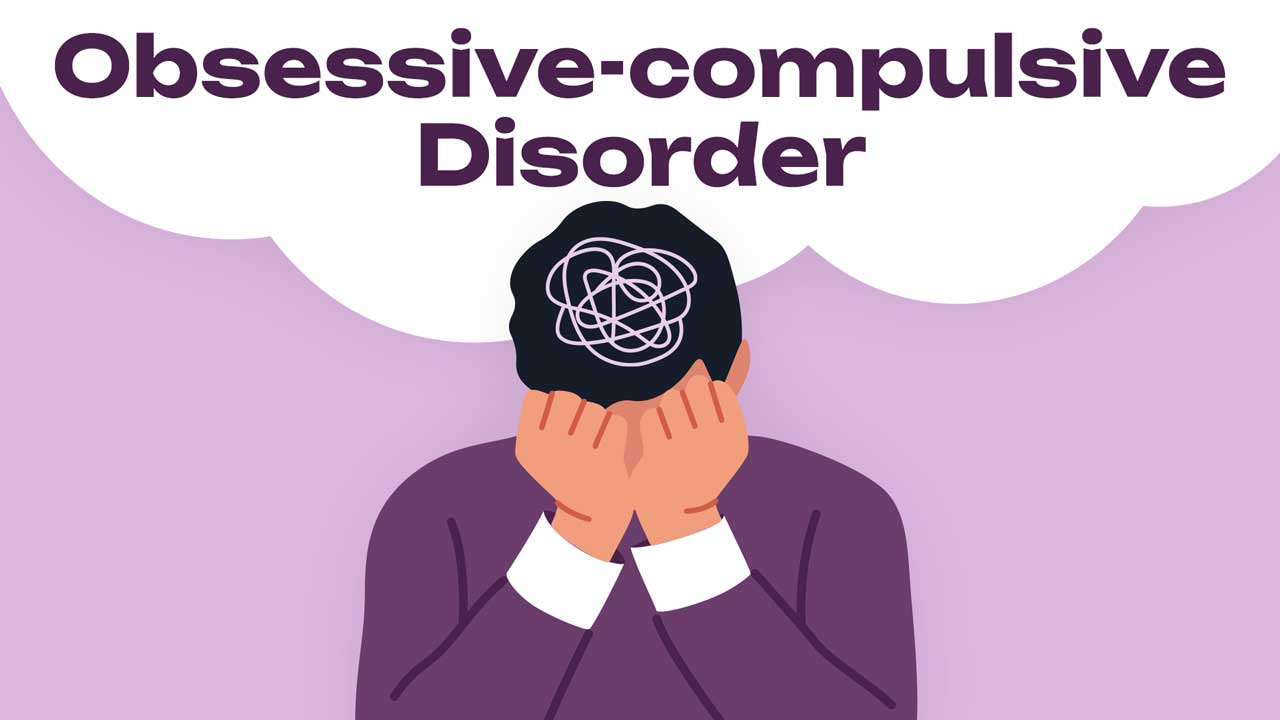Obsessive-compulsive disorder (OCD) is a mental illness as per the Diagnostic and Statistical Manual of Mental Disorders DSM-5-TR (APA 2022).
OCD is estimated to affect about 3.6% of Australians - more than 500,000 people (ABS 2023; Healthdirect 2024).
The primary features of OCD are the presence of obsessions and compulsions. They are defined by the DSM-5 TR as:
- Obsessions: Repetitive and relentless thoughts, impulses or urges that are unwanted and often intrusive. These thoughts cause anxiety and distress.
- Compulsions: Repetitive behaviours (often the examples of handwashing and ordering are used) or mental activities such as praying, counting and/or repeating words silently. The individual will feel compelled to carry out these acts in an attempt to quell their obsessive thoughts.
(APA 2024; Brock et al. 2024)

These obsessions and compulsions will be time-consuming, sometimes taking up more than an hour a day. They cause significant distress and either social or occupational impairment or hinder another important area of functionality (APA 2024). In very severe cases, OCD can cause a person to be housebound (Better Health Channel 2022).
OCD typically presents during childhood, adolescence or young adulthood (APA 2024).
It’s common for people who have OCD to also live with other mental health conditions such as an anxiety disorder (e.g. social anxiety or panic disorder) or depressive disorder (Healthdirect 2024).
People who have OCD often report feeling deep shame about their behaviours and compulsions. These feelings of shame can exacerbate the problem, and cause people to delay seeking help and treatment (Better Health Channel 2022).
OCD previously existed under ‘Anxiety Disorders’ in the earlier edition of the DSM (DSM-IV). However, it is now grouped with conditions such as hoarding and body dysmorphia under the category ‘Obsessive-Compulsive and Related Disorders’ in the DSM-5 (Brock et al. 2024).
The Difference Between Obsessive-compulsive Disorder and Obsessive-compulsive Personality Disorder
It is important to note that obsessive-compulsive disorder (OCD) is distinct from obsessive-compulsive personality disorder (OCPD).
The essential feature of OCPD is defined by the DSM-5 as:
‘A preoccupation with orderliness, perfectionism, and mental and interpersonal control, at the expense of flexibility, openness, and efficiency. This pattern begins in early adulthood and is present in a variety of contexts … Despite the similarity in names, OCD is usually easily distinguished from obsessive-compulsive personality disorder by the presence of true obsessions and compulsions in OCD.’
(OCD-UK n.d.)
Causes of Obsessive-compulsive Disorder
While it’s not known what exactly causes OCD, the condition is generally thought to occur due to a combination of factors such as:
- Genetics
- Abnormalities of the brain
- Irregular neurotransmitter systems
- Environmental triggers
- Behavioural factors.
(Healthdirect 2024; BeyondOCD 2019a)
Symptoms of Obsessive-compulsive Disorder
Obsessions
Obsessions are intrusive and unwanted thoughts, images and urges that cause distress and anxiety. A person will not derive pleasure from them and they are not voluntary. A person will attempt to neutralise these through compulsions. Obsessions may include:
- Repetitive or persistent thoughts or images, for example, a deep fear of contamination
- Intrusive thoughts and images, for example, of a violent or frightening nature
- Unwanted and distressing urges.
(APA 2024; Better Health Channel 2022)
Compulsions
Compulsions are behaviours or mental acts intended to reduce anxiety and stress caused by an obsession. Often, they are not linked with what they are designed to dull or prevent in a way that would be considered realistic, and/or they are clearly excessive. Examples include:
- Handwashing
- Ordering
- Checking
- Praying
- Counting
- Repeating words or numbers.
(APA 2024; Better Health Channel 2022)
Diagnosing Obsessive-compulsive Disorder

According to the DSM-5-TR, a diagnosis of OCD is made if:
- Obsessions and compulsions are present
- The obsessions and compulsions take up a significant amount of time or result in notable distress or functional impairment
- The symptoms cannot be explained by another medical condition or the effects of a substance, and
- The symptoms cannot be more accurately explained by another mental disorder.
(Brock et al. 2024)
Treatment for Obsessive-compulsive Disorder
OCD is treatable. Seeking professional support and treatment is crucial to being able to start or resume a life that is not impeded by overwhelming anxiety and distress.
There are two main types of effective treatment for OCD: psychological treatment and treatment with medication (APA 2024).
Psychological Treatment
The primary treatment for OCD is cognitive behavioural therapy (CBT). It’s important for patients to find a cognitive behavioural therapist who is specifically trained and experienced in OCD (BeyondOCD 2019b).
CBT usually involves two kinds of evidence-based techniques:
- Exposure and response prevention therapy (ERP)
- Cognitive therapy (CT).
In ERP therapy, a therapist will gradually expose the person with OCD to the situations that trigger their obsessions and/or compulsions. The aim is that over time, the person will learn to respond differently to these triggers. Eventually, the frequency of compulsions and the intensity of obsessions will reduce (BeyondOCD 2019b).
In CT, a person will be encouraged to identify patterns of thought that create anxiety, distress or negative behaviour, and learn to modify them. CT helps a person to understand that their brain is sending false and unhelpful messages. They learn to recognise these messages and respond to them differently (BeyondOCD 2019b).
Medication
Medication can be effective in helping to restore the brain’s normal chemical balance, which may help to control obsessions and compulsions (Healthdirect 2024). The recommended first-line medication is a selective serotonin reuptake inhibitor (SSRI) (Brock et al. 2024).
Neuromodulation
Neuromodulation treatments, such as transcranial magnetic stimulation, stereotactic ablation and deep brain stimulation, may also be effective in treating OCD (Brock et al. 2024).
Support Groups
A community support group may be beneficial for someone living with OCD, as it can provide an environment in which people living with OCD and their families can give and receive support and form social networks (Better Health Channel 2022).

Support for Family, Friends, and Carers
Living with someone who has OCD can be challenging. Their behaviours may seem hard to understand or disruptive. However, it’s important to recognize that they are likely as distressed by their symptoms as you are (SANE 2018).
Plenty of resources are available to help clear up misunderstandings about OCD and its symptoms, ensuring better support and understanding for everyone involved.
Test Your Knowledge
Question 1 of 3
Which one of the following is NOT a compulsion associated with OCD?
Topics
References
- American Psychiatric Association 2022, The Organization of DSM-5-TR, APA, viewed 21 November 2024, https://www.psychiatry.org/File%20Library/Psychiatrists/Practice/DSM/DSM-5-TR/APA-DSM5TR-TheOrganizationofDSM.pdf
- American Psychiatric Association 2024, What Is are Obsessive-Compulsive and Related Disorders?, APA, viewed 21 November 2024, https://www.psychiatry.org/patients-families/obsessive-compulsive-disorder/what-is-obsessive-compulsive-disorder
- Australian Bureau of Statistics 2023, National Study of Mental Health and Wellbeing, Australian Government, viewed 21 November 2024, https://www.abs.gov.au/statistics/health/mental-health/national-study-mental-health-and-wellbeing/latest-release
- Better Health Channel 2022, Obsessive Compulsive Disorder, Victoria State Government, viewed 21 November 2024, https://www.betterhealth.vic.gov.au/health/conditionsandtreatments/obsessive-compulsive-disorder
- BeyondOCD 2019a, What Causes OCD?, BeyondOCD, viewed 21 November 2024, https://beyondocd.org/ocd-facts/what-causes-ocd
- BeyondOCD 2019b, Cognitive Behavior Therapy, BeyondOCD, viewed 21 November 2024, https://beyondocd.org/information-for-individuals/cognitive-behavior-therapy
- Brock, H, Rizvi, A & Hany M 2024, ‘Obsessive-Compulsive Disorder’, StatPearls, viewed 21 November 2024, https://www.ncbi.nlm.nih.gov/books/NBK553162/
- Healthdirect 2024, Obsessive-Compulsive Disorder (OCD), Australian Government, viewed 21 November 2024, https://www.healthdirect.gov.au/obsessive-compulsive-disorder-ocd
- OCD-UK n.d., Clinical Classification of Obsessive-Compulsive Personality Disorder (OCPD), OCD-UK, viewed 21 November 2024, https://www.ocduk.org/related-disorders/obsessive-compulsive-personality-disorder/clinical-classification-of-obsessive-compulsive-personality-disorder/
- SANE 2018, Obsessive Compulsive Disorder (OCD), SANE, viewed 21 November 2024, https://www.sane.org/information-and-resources/facts-and-guides/obsessive-compulsive-disorder
 New
New 
